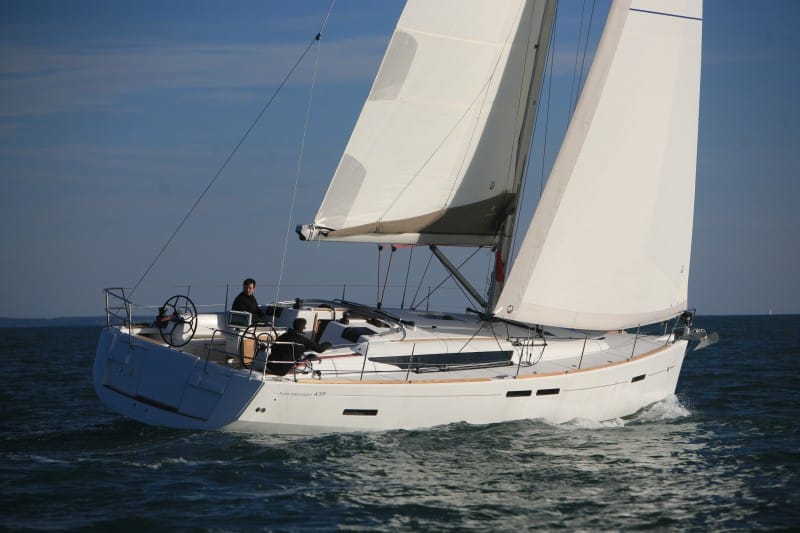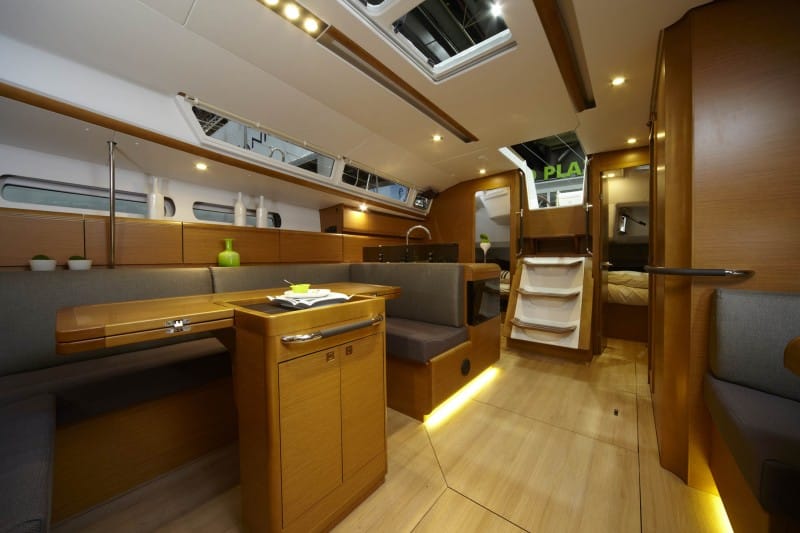
Building on the success of the Sun Odyssey 409, Jeanneau has completely revamped their Sun Odyssey line of cruisers. As with most major manufacturers, their entire range seems to ratchet up in size with every retooling. Their new Sun Odyssey 439 and 44 DS, which would have once represented the upper end of their offerings, are now nestled well in the middle of the pack, size-wise.
Although they share the exact same Philippe Briand designed hull, the 439 and 44 DS are on completely different missions. Once a potential customer has settled on basic size and price point, Jeanneau hopes to keep them in the family by offering either the elevated and commodious interior of the 44 DS or the more traditional deck layout and better sailing performance of the Sun Odyssey 439.
Jeanneau has added a gene to their DNA with the inclusion of a hard chine throughout their new range. Although actually an old idea, I find this “new look” attractive, and, in theory, these chines should add to the form stability, lateral resistance, and hull rigidity. I say in theory because the chine is placed relatively high on the hull and would not come into its own unless on a heavy heel.
The Sun Odyssey 439 is a thoroughly modern family cruiser, incorporating several of the latest design trends. I am a convert to the concept of twin helms. Two helms add redundancy to the steering system, permit the helmsperson a clear view of the sail trim on both tacks, and a choice of sides to steer from when maneuvering in tight conditions. They open up the aft entrance into the cockpit, which allows for the imminently practical drop-down transom/boarding platform. They free space for a walk-around cockpit table, which holds the navigation screen, stowage space, and cup holders, and folds out large enough to become the main entertaining center. Add to that the clear separation the binnacles create between the work and leisure areas and I rest my case.
One of the core concepts of the 439 is to bring all sailing functions back to the cockpit, and the most immediate of them, the sheets, directly to the helm stations. The primary winch placement lies readily at hand for the helmsperson, qualifying this as a short-handed cruiser. All this running rigging running aft from the mast is hidden under sea hoods, leaving the deck clean looking and clear of obstructions.

The pushpit rails extend forward of the helms creating a sense of security. I did find, however, that the double backstays intrude on the otherwise comfortable steering stations, and the dodger and bimini set-up obstructed the view of the sails. The flow forward is clear, with aggressive non-skid, good handholds, double lifelines, and a flat and practical foredeck workstation. The anchor rollers extend far enough forward to protect the plumb stem.
Jeanneau does a nice job of partnering rich woods with white paneling to create an interior that is simple yet stylish. They offer several layout options, but I believe the most popular choice will be the three-cabin/ two-head version as it offers a spacious private owners cabin forward with a handy seat and vanity desk. Especially as the demographics of sailing are increasing in age, the more easily accessed island berth in this option will find favor. The double-berth aft cabins are spacious enough to house a gaggle of guests.
The entire interior is awash with light due to eight deadlights and eleven ports and hatches. The main saloon is spacious yet rendered safe at sea with the strategic placement of several leather covered stainless-steel handholds. The main saloon table is cleverly designed. A fixed center console creates a fiddled stowage space on top and a wine/liquor cabinet below. The table leaves flip over instead of dropping down, thus it can be used at half size, or doubled without having to evacuate the seats or interfering with knee space.
Across the aisle a divided settee has a central cocktail table/navigation station, that with the flip of the seats becomes his & hers computer stations.
The L-shaped galley is well thought out with generous fiddled counter space, usable stowage areas, double stainless-steel sinks, two-burner stainless-steel stove/oven, and an attractive splashguard separating the galley from the main saloon.
The wind gods of the Chesapeake favored us with 10-18 knots of breeze on our test day. We easily managed 7 knots respectably close to the wind, and hit the polar predictions on all other points of sail. Partially due to the in-mast furling system, I felt the gooseneck was inordinately high above the waterline. This not only reduces the mainsail area but also raises the center of effort, both detracting from the overall sailing performance. This may account for the excess weather helm we experienced. I believe the traditional slab-reefing mainsail option is more congruent with the 439’s performance persona.
The Yanmar 54-horsepower diesel, driving a three-bladed fixed prop, pushed us at 7 knots with power to spare. The boat backed well due to its deep spade rudder. The Lewmar helms are solid yet responsive, and the controls are well laid out and easily at hand.
In summary, I did not find the performance or deck ergonomics of the 439 equal to that of the smaller Jeanneau 379. Having said that, selecting a different option for the rig and rethinking the dodger/bimini set-up would go a long way to mitigate that. The 439 is well conceived, and for the most part well executed. It offers a balance of style, performance, and lush living, and it does so at an attractive price. Most importantly, Jeanneau builds and backs solid boats with their commendable two-year “bumper to bumper” warranty.
The Jeanneau Sun Odyssey is part of Cruising World‘s 2012 New Boat Showcase.








